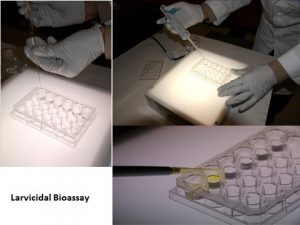Discovery of Natural Mosquito Pesticides and Repellents
We are screening natural product for the larvicidal activity and repellency against mosquitoes for the last 10 years. We have screened thousands of samples and have a huge database available.
We have following bioassay systems available in our laboratory:
1. In vitro Klun and Dubbon (K&D) bioassay
2. In vitro Ali and Khan (A&K) bioassay.
Feeding device used in the A&K in-vitro assay showing the landing and feeding of Aedes aegypti females on 7.5 x 4 cm treatment area inside the blood box. Control vs repellent treatment.
3. In vivo cloth patch bioassay
4. Larvicidal screening bioassay

Bed Bug Remedy
As globalization/urbanization has brought people closer, this has brought urban pests like bed bugs and roaches into homes. The use of chemical insecticides, especially with long-lasting residues, leaves humans at risk for chemical exposure. Bed bug is a zero tolerant pest which rules out the use of repellents. NCNPR has established a research facility for the evaluation of natural products against these pests. Our aim is to look for answers for their management from natural resources that are safer and without toxic residues.
We are profiling the toxicity of essential oils, extracts, compounds, etc. against two strains of bed bug ‘Cimex lectularius L.’ (Bayonne ‘Insecticide resistant’ and Ft. Dix ‘Susceptible’) using three different delivery methods: topical, residual and fumigation. The topical and residual bioassays address the contact toxicity while the fumigation bioassay reveals the vapor toxicity of the test candidate. Studies are conducted to discover synergistic combinations of compounds that enhance efficacy. Based on these findings we design bed bug management strategies and can synthesize/test analog compounds to optimize potency. Promising lead compounds are further tested on different substrates (e.g., floor tiles (vinyl, ceramic), wood panels, chairs, tables) to determine their efficacy in actual conditions.
The current trends of increasing travel and population growth will continue to fuel the spread of these unwanted pests. Therefore, continued efforts to discover and develop effective products remains a priority.







